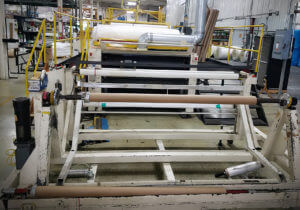Demystifying Belt Lamination: The Method and Its Benefits

What is the purpose of laminating?
Here’s the thing about lamination–it encompasses more products and processes than you may think. That means its purposes stretch equally far. You’ll find a wide variety of benefits come with lamination. They include:
Protection. One of the primary reasons why we laminate products is that it protects the final product from damage. It’s all too easy for ink to smear and for designs to be unintentionally ruined. Laminates act as protective layers, preserving the design for the long term. Not only does this prevent smudging–UV-blocking laminates protect sensitive inks from UV rays.
Laminate makes prints last longer. Of course, the more protective the laminate, the longer the product tends to last. Most of the materials we can laminate are fragile. Not only are the ink and the designs involved easily smudged; the materials themselves tend to tear, wrinkle, and fray. Laminate prevents this from happening. It also makes it easier to wipe them down with cleaners.
They’re more cost efficient. Of course, if a product lasts longer and is less prone to damage, it naturally becomes more cost efficient in the long term. However, the incorporation of laminate also allows you to use thinner paper, which is typically less expensive. The laminate makes the product feel weightier, which is exactly what you want. Additionally, burnish-resistant laminates enable you to skip slip sheets and shrink packaging–further saving you money.
Lamination increases revenue. How does this work? As we’ve already covered, laminate makes products more accessible–and multipurpose. This means you can reach a wider variety of potential clients. Laminate offers you a flexibility that covers everything from utilitarian projects to more artful commissions. The more services you can offer, the more revenue you’ll bring in over time.
What are the different types of lamination?
Belt lamination isn’t the only type of lamination on the market. Technically, you’ll find different typed lamination processes, and then different types of final products. For example, that process uses both controlled heat and pressure to create a bond between materials, with the lamination belt acting as a conveyor. The material runs through the double belt press, and passes through different heating and cooling zones. Those zones allow for adhesion, ensuring that as the product leaves the conveyor belt lamination machine, there isn’t any separation.
Additionally, there are different variations within the belt lamination process. These include double belt press lamination, lamination wide and narrow belt based. Depending on the belt laminator you use, you could also execute flatbed laminating.
Moving on, we’ll see different types of final lamination products after completing the processes. These include:
Soft touch lamination. This type of lamination offers two different sensory experiences. The product looks matte and offers a soft, silky feeling. It’s almost like velvet. Keep in mind, this is a higher end type of lamination. This makes it among the more expensive options as well.
Glossy lamination. Among the smoothest types of lamination, it’s shiny and reflective, creating an attractive appearance. Often, we apply this type of lamination to both sides of the product, ensuring its protection extends to every part.
Matte lamination. This lamination lacks the shiny qualities of glossy lamination, which makes it easier to read–no worries about a glare here! There’s a natural, sophisticated look to this type of lamination.
Nylon flat lay lamination. Usually, you’ll find this lamination in book jackets and covers. While other types of laminate tend to curl, this laminate lays perfectly flat. At the same time, it provides the degree of protection you seek from similar laminates.
Why is lamination so strong?
The strength of laminate lies in several different factors. For one thing, we apply laminate in layers. Those layers create a higher degree of durability, which enhances the overall strength of the product. The more layers you have, the stronger the coating–to an extent. But it’s not just the presence of the layers themselves–we also build stability through how we apply those layers. When you orient the layers in different directions, that increases the overall strength of the final product. This technique stabilizes the laminate.
The materials we use in laminate increases the overall power of the product. So much of the lamination process depends on adhesives. That adhesive factor creates an incredibly strong product. It acts as a sealant, protecting the product from damage and weakness. Furthermore, the smoothing effect of laminate increases that durability as well. It levels out flaws in the product, and increases the overall strength.
In short, not only is the product stabilized by lamination–it’s also protected. The laminate itself is strong, and it makes the laminated product that much tougher as well.
Food for Thought:
It’s difficult to go without lamination in certain sectors of the manufacturing industry in this day and age. And with good reason! It’s important for you to consider the type of lamination you need before committing to a project, as well as how you’ll have it executed. Here’s the thing: you don’t have to have products laminated in-house. Third party manufacturers stand as great alternatives. This can be ideal for growing businesses that need to scale up quickly, efficiently, and with great quality control.
Conversion Technologies International is here to help you figure it all out, from the laminating belts you use to the final product. Contact us here or give us as a call at 419-924-5566 for more info!
- << < Previous Post
- 1
- 2
- ...
- 241
- 242 Next Post > >>

